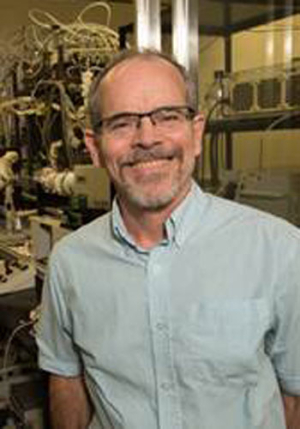Inside the University of Houston Texas Diesel Testing and Research Center, space is typically reserved for finding ways to clean harmful pollutants from diesel vehicle exhaust through retrofit systems attached to tailpipes.
But recently, diesel center researchers have taken on a new project intended to expand the center’s clean air focus. They are examining glass beakers filled with samples of a slimy green substance most find growing in ponds, swamps and even dirty swimming pools.
It’s a mixture of algae and other aquatic biomasses, and these researchers think it has the potential to be the next conventional oil alternative.
“Algae is a high yield crop that holds promise as a source of renewable liquid fuels,” said Michael Harold, a professor of chemical and biomolecular engineering who works with the diesel center. “Algae can be grown rapidly and continuously on non-arable land in fresh and salt water. Unlike other biofuel sources such as corn, soybeans or sunflowers, there is no competition with our food crops.”
In fact, Harold says, no more than two percent of the United States existing cropland is needed for algae to produce enough fuel to meet half the country’s demand. It’s the smallest necessary from a biofuel source. Others require anywhere from 30 to 262 percent to produce the same amount.
So he and other researchers at the diesel center are partnering with Sunrise Ridge Algae Inc., a Houston, Texas company, to explore its promise as a liquid fuel source.
Using a method called pyrolysis, these researchers are heating algae to temperatures as high as 600 degrees Celsius. The absence of oxygen during heating protects the algae and other aquatic biomass substances from burning and accelerates the break down of the molecules of its three major components—lipids, carbohydrates and proteins. The hot gases produced by heating are then condensed to get a liquid that resembles crude oil.
It is the same method used to make charcoal, says Rachel Muncrief, a research assistant professor with the diesel center. Researchers are just adding a few of their own twists.
“Algae can be pyrolyzed into a product that has a reasonably high energy content,” Harold said. “It can have an energy content that is maybe only 10 or 20 percent below that of traditional petroleum-derived fuel.”
The challenge for them now is to make it viable for processing with current refinery technology.
“Refineries deal everyday with feedstocks that have a variety of impurities and compositions, so it all comes down to whether or not we can we tailor the algae pyrolysis to give a pyrolysis oil that is within the window of stability and quality that a conventional refinery can handle,” Harold said. “We have to work some more with the complex mixtures that result from the pyrolysis to create a product that can be processed in refineries.”
One of the most basic organisms these substances grow quickly—doubling in mass every day or two, which makes them an ideal choice, according to Robert Weber, chief technology officer for Sunrise Ridge Algae. Like many plants, they also have the added benefit of helping clean the air and water because they require carbon dioxide and dissolved nutrients to grow.
The hope is that this method will allow a more environmentally friendly fuel source to find its way to consumers in a matter of just a few years.
“Our goal is to find a way to make it in large quantities that can be put into existing refinery streams and reduce our growing dependence on imported crude oil," Muncrief said. "Algal fuels are carbon neutral so not only will this help limit climate change, but we think it may be easier and more cost effective than other techniques out there currently being used to create biofuels.”

